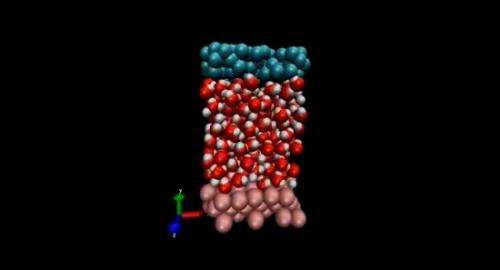New technique controls fluids at the nanoscale

(Phys.org) —Researchers at Swinburne University of Technology have revealed a revolutionary method of pumping fluid at the nanoscale level that has potential use for desalinating water and lab-on-a-chip devices.
They have developed a simple, highly accurate model to predict fluid movement for highly confined fluids and to then use this knowledge to drive flow without mechanical pumping or the use of electrodes.
"Conventional fluid dynamics modelling works perfectly with things we can see such as the flow of air over an aircraft," Swinburne's Professor Billy Todd said.
"But when devices get to nanometre size or 1 billionth of a metre – about one ten-thousandth the diameter of a human hair – the fundamental assumptions of fluid mechanics break down. It is difficult to force fluid to flow in confined dimensions that are just a few atoms thick."
Professor Todd is Chair of the Department of Mathematics in the Faculty of Science Engineering and Technology at Swinburne. Together with colleagues at Swinburne, RMIT and Roskilde University in Denmark, he has applied ideas from mathematics and physics, and used supercomputers to look at what happens at the interface between the solid surface and the fluid at nanometre dimensions.
"Several years ago, researchers in France and Germany developed a theory that a rotating electric field could induce water molecules to spin and that this spin motion could be converted into linear streaming fluid motion," Professor Todd said.
"If the symmetry of the confining walls could be broken such that one wall was hydrophilic and attracted water, while the other was hydrophobic and repelled water, then mathematically it was demonstrated that water could be made to flow in just one direction, namely along the channel."
Professor Todd's team has further developed that theory and performed the first molecular dynamics computer simulations to demonstrate this effect, mimicking nanoconfined water under the application of a rotating microwave field.
What they found was that the use of circularly polarised microwaves could drive substantial flow at the nanoscale without significantly heating the water.
"Flow can be sustained when the fluid is driven out of equilibrium by an external uniform rotating electric field and confined between two flat surfaces with different degrees of hydrophobicity, thus opening up an entirely new way to pump and control fluid flow confined to nano or micro-metre scale dimensions," Professor Todd said.
He said this discovery has potential application for desalinating water as well as for biotech diagnostic tools such as lab-on-a-chip devices.
This research was recently published in Langmuir. Professor Todd is now seeking an experimental partner to verify this model in a lab.
More information: "Molecular Dynamics Study of Nanoconfined Water Flow Driven by Rotating Electric Fields under Realistic Experimental Conditions." Sergio De Luca, B. D. Todd, J. S. Hansen, and Peter J. Daivis. Langmuir 2014 30 (11), 3095-3109. DOI: 10.1021/la404805s
Journal information: Langmuir
Provided by Swinburne University of Technology



















